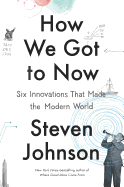
In several of his eight previous books, Steven Johnson (Future Perfect; The Ghost Map) has applied his fertile mind to exploring various aspects of creativity and invention. His ninth, How We Got to Now, the profusely illustrated companion to an upcoming PBS series, offers a fascinating glimpse at how a handful of basic inventions--such as the measurement of time, reliable methods of sanitation, the benefits of competent refrigeration, glassmaking and the faithful reproduction of sound--have evolved, often in surprising ways.
Johnson's treatment of each of his chosen innovations follows a similar pattern: he introduces the subject with an anecdote (as with the discovery of whale oil) or a brief sketch of a character--some obscure (Ellis Chesbrough, who solved Chicago's sanitation problem in the 1850s), others well-known (Galileo, Edison)--and then traces how "an innovation, or cluster of innovations, in one field ends up triggering changes that seem to belong to a different domain altogether." Though in part this is a history of ideas, it's much more the story of the collaborative process, one that's often unintentional and diffuse.
Though Johnson describes himself as "resolutely agnostic" on whether all the changes wrought by these chains of innovation ultimately have been for the better, this is a fundamentally optimistic book, if only in the way it pays tribute to our creativity as a species. And when you put on your eyeglasses to read it with a glass of clean, icy drinking water in your hand, you'll be less likely to view these and other features of modern life as commonplace instead of the marvels they are. --Harvey Freedenberg, attorney and freelance reviewer

